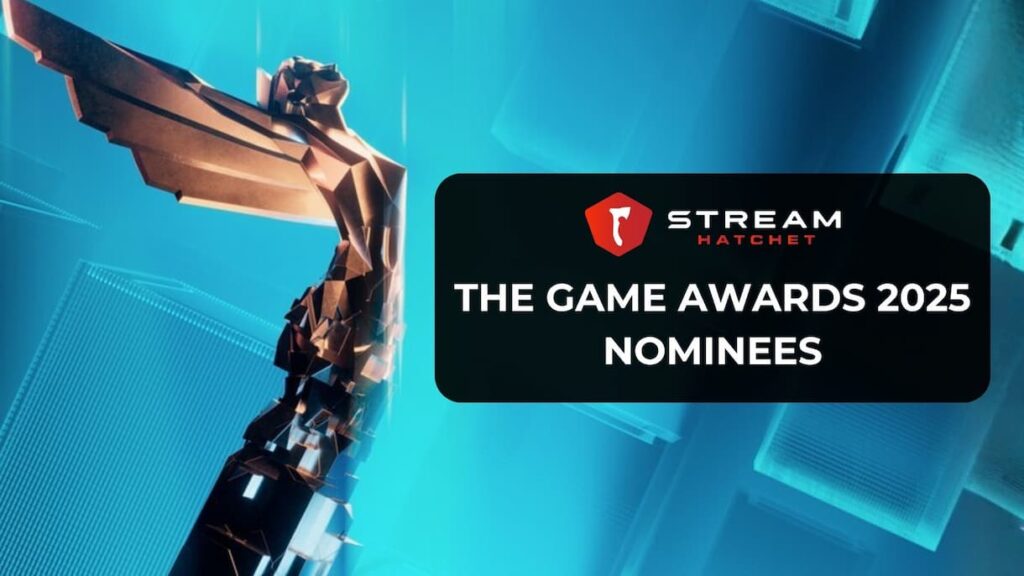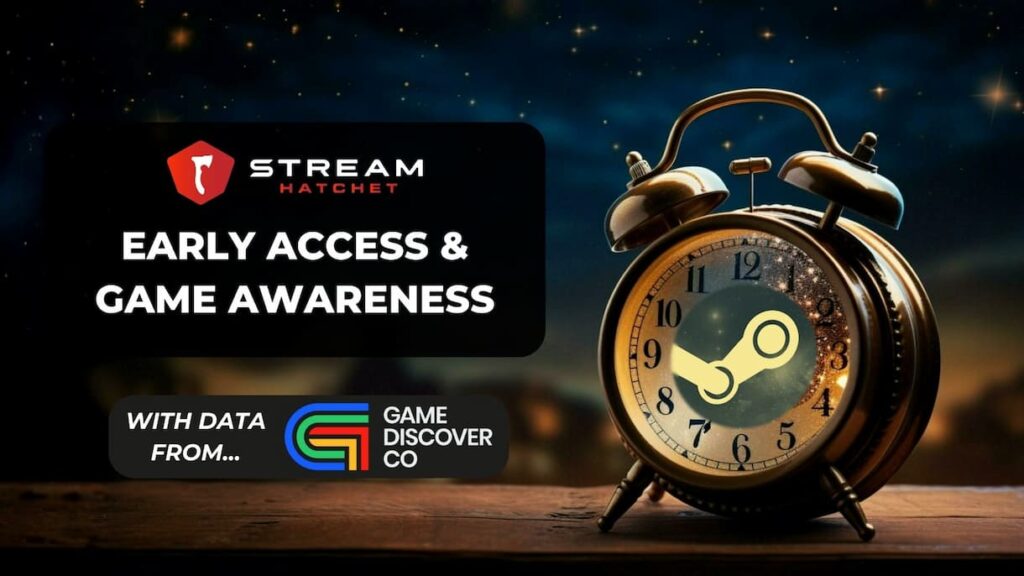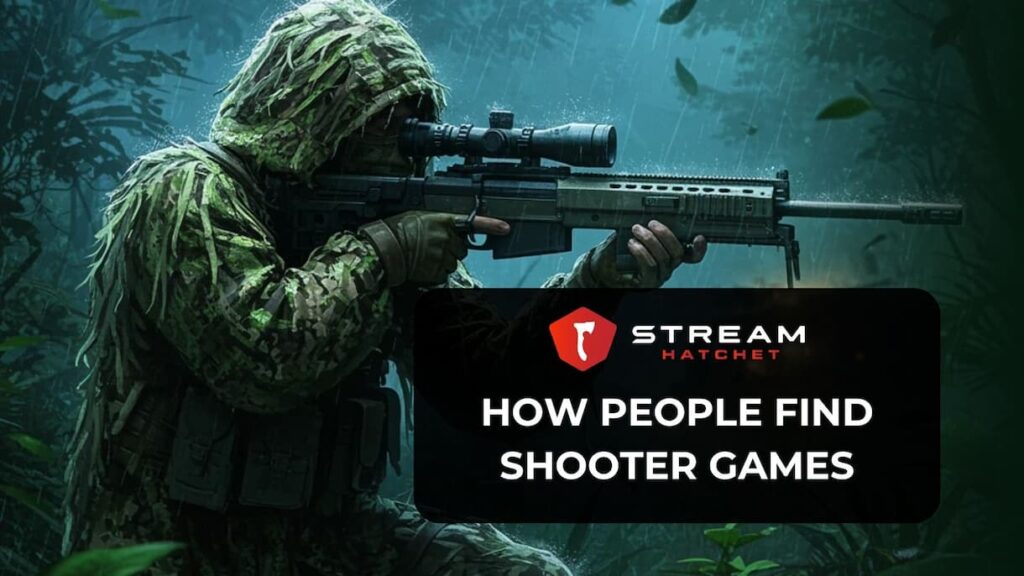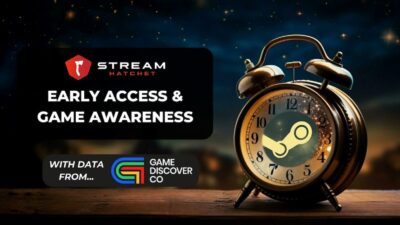PUBG: Battlegrounds (PUBG) sparked the battle royale revolution. The entirety of online gaming has since been dominated by the genre, from copycats like Apex: Legends to twists on the formula like Fall Guys. These games thrive on the adrenaline-pumping tension of competing to become the last survivor.
PUBG is now celebrating its 7th anniversary, having originally released on Steam on the 23rd of March 2017. PUBG was the brainchild of Brendan Greene, an Irish programmer who found his footing in the genre by creating the ARMA 2: DayZ Battle Royale mod. Over the seven years since these humble beginnings, the performance of PUBG has been closely affected by shifts in the greater streaming landscape: The COVID pandemic, the free-to-play proliferation, and many others. Reflecting on PUBG’s performance means reflecting on the modern gaming industry itself.
To that end, this retrospective looks back over the challenges that PUBG has faced in its lifetime, what these challenges say about the evolving streaming landscape, and how PUBG has morphed into esports and mobile forms to reach new fans.
PUBG’s Breakout Success Ushered in a New Era for Gaming
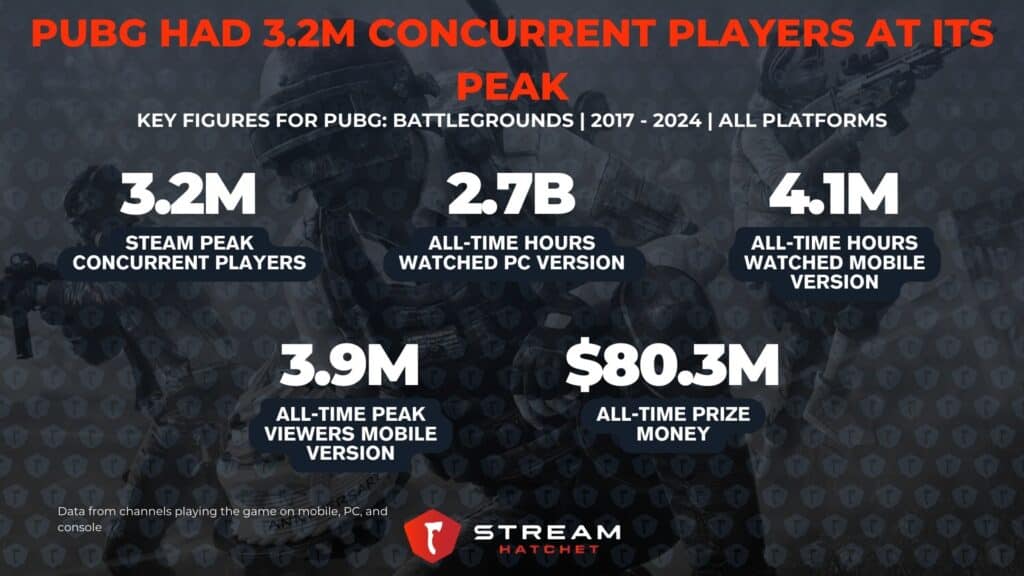
PUBG was an immediate phenomenon upon its release. The game sold 50 million copies across PC and Xbox in its first year, surpassed League of Legends viewership on Twitch, and earned the honor of Best Multiplayer Game at 2017’s Game of the Year awards. Since then, PUBG has become the 5th best-selling game of all-time with 75 million copies sold, and currently sits at the 14th most watched game across all streaming platforms for March 2024 with 11.6M hours watched.
Although battle royales had existed before, such as H1Z1 in 2015, something about PUBG captured the gaming community’s attention. It certainly wasn’t the game’s performance – it was rife with bugs and glitches during the 6 months of its early access. Yet despite this, the game’s gritty realism, expansive maps and gameplay fuelled by escalating tension kept players coming back.
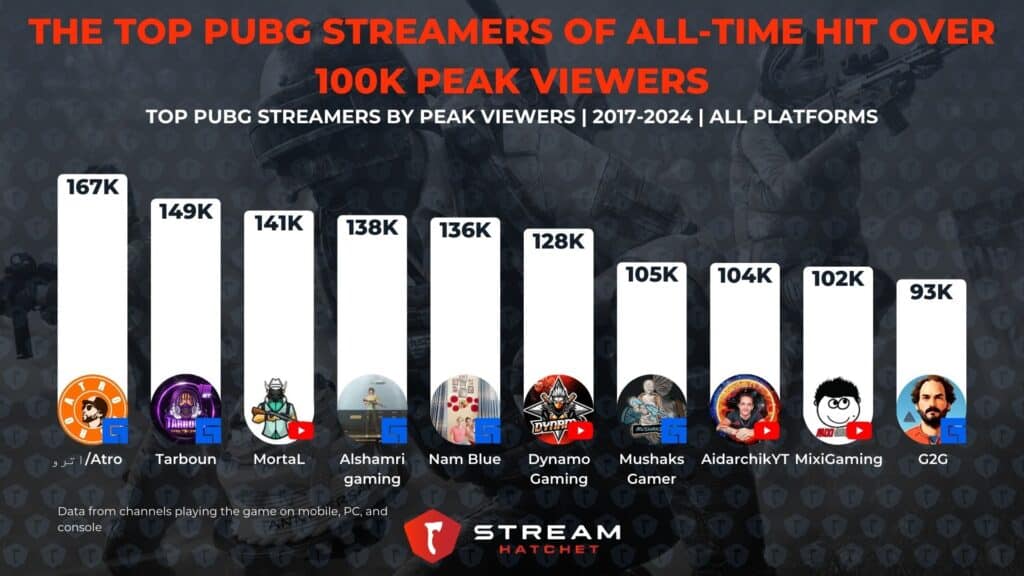
Crucially, it was content creators that generated hype for the game. Atro/اترو has the highest all-time peak viewership of any PUBG streamer, with 166K in January 2021. Atro, along with every other top 10 PUBG streamer listed, is known for playing the mobile version of the game – the success of which is discussed below. A couple of them are best known for playing competitively, namely Dynamo Gaming and MortaL. These streamers almost solely focus their attention on PUBG, reflecting the devotion needed to master a game with seven expansive maps.
Although PUBG Mobile players are the most popular PUBG streamers of all-time, it was early adopters of the PC version of the game that built the fan base. Streamers like Grimmmz, Anthony_Kongphan and CohhCarnage created a culture of engaging viewing: Watching your favorite player vie for the exclusive title of last survivor pulled you into the action, sometimes just as much as playing the game yourself.
PUBG Streaming Performance Tracks Shifts in the Gaming Industry
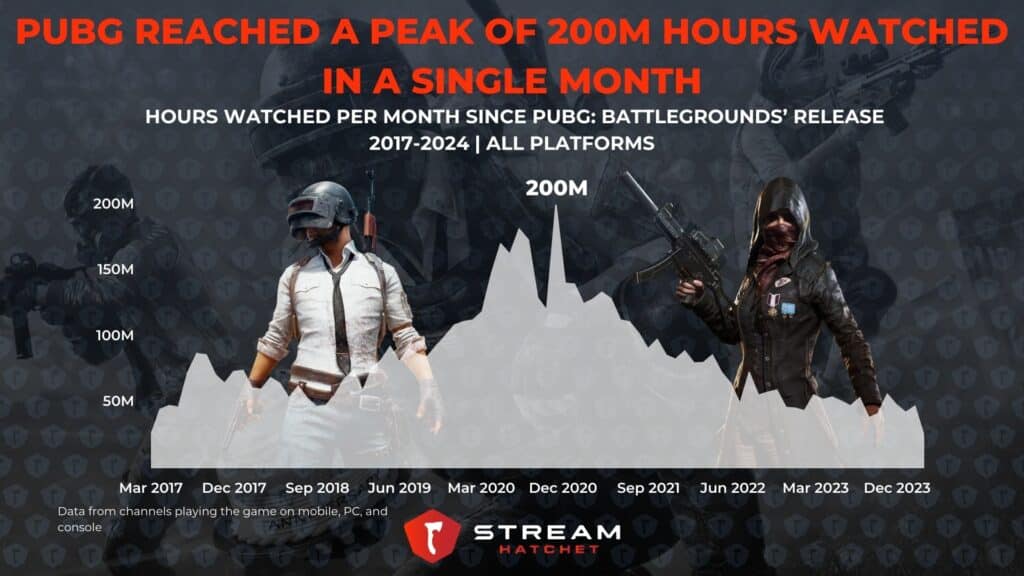
Given the monumental success of the game’s release, an inevitable downturn was expected. In saying that, PUBG viewership has fallen to a small fraction of its peak: From 200M hours watched in November 2020 (the height of the pandemic), to just 46M in February 2024. A series of shifts in the industry, competition, and gaming philosophy more broadly have determined the performance of the game in streaming.
Competition chipped into PUBG’s player base, with PUBG becoming a victim of its own success. Looking specifically at battle royale shooters, the three big rivals to PUBG’s stranglehold over the genre are Fortnite: Battle Royale, Apex Legends and Call of Duty: Warzone. Even though PUBG currently sits at 11.6M hours watched for March, it is outperformed by each of its rivals – Warzone and Apex with roughly 4M each, and Fortnite with 7M. In particular, Fortnite’s Battle Royal mode was hugely damaging: It was released just six months after PUBG, and it was free-to-play. Gamers who wanted to dip their toe into the battle royale genre picked up Fortnite first, became used to it and never made the paid transition to PUBG.
PUBG itself went free-to-play in January of 2022, which temporarily helped to bolster viewership. In just one month, hours watched jumped from 15M to 22M for the PC/console version of PUBG. This resurgence was short-lived however, with viewership back to the earlier levels by September of 2022. Many fans of the series decry the “Fortnite-ification” of PUBG, criticizing the game for shedding its gritty realism in favor of the meme-culture and faster pacing of Fortnite.
PUBG Streaming Makes Strides in the Growing Esports Industry
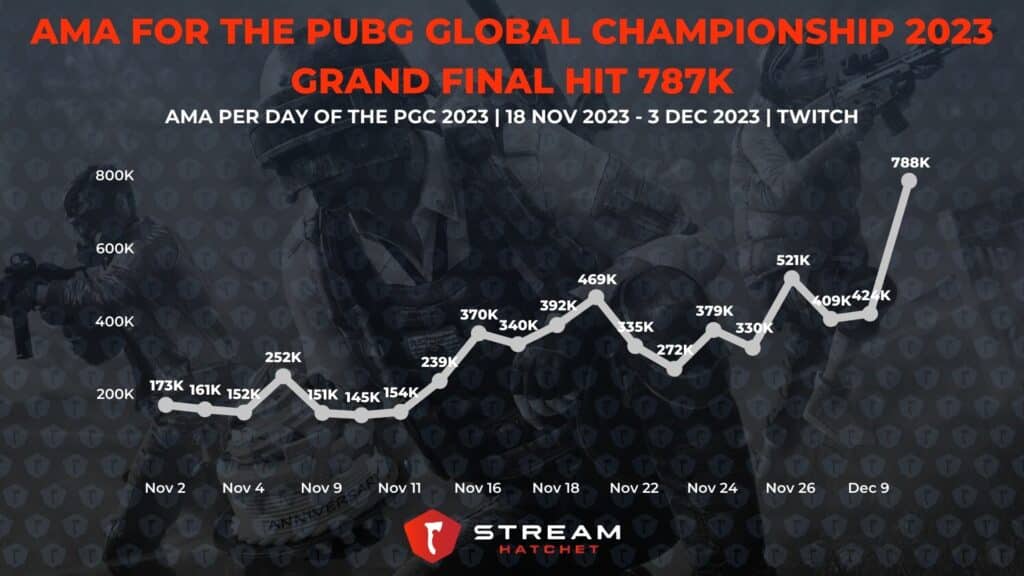
PUBG esports is serious business: The PUBG Mobile tournaments alone have awarded $80M USD in prize money since their inception in 2018. Across every PGC event, 465M hours have been watched – that works out neatly to roughly $1 of prize money for every 10 hours watched. Last year’s PUBG Global Championship 2023 was a strong showing as well, garnering a massive 30.6M hours watched across its 20-day run with 4.3M of those hours coming from the Grand Final event on the 10th of December. PUBG Esports themselves reported a peak of 1.5M unique viewers for the 2023 event.
PUBG’s Smartest Move Was Going Mobile, Rocketing to Success in India
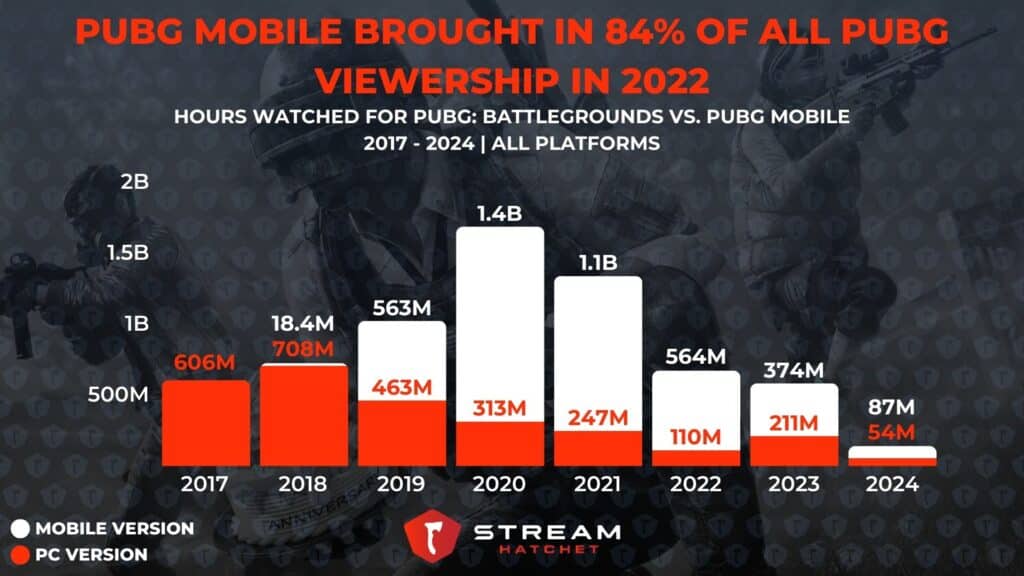
PUBG is celebrating another anniversary this month: PUBG Mobile’s 6th anniversary, historically the game’s most popular variant with a monumental peak viewership of 3.9M in 2020. For much of PUBG’s lifespan, PUBG Mobile has generated the majority of streaming interest. For three years, from 2020 to 2022, PUBG Mobile contributed greater than 80% of total PUBG viewership. This is surprising, considering that in 2022 mobile gaming contributed only 19% of esports viewership.
While PUBG Mobile’s numbers were certainly bolstered by pandemic-era gaming, there was one particular reason for the mobile version’s meteoric rise to prominence: A new player base in India. In August of 2020 as an example, India generated 10 times the PUBG Mobile viewership of the next most popular country, Indonesia. Given that PUBG depends on India for so much of its viewership, the region is essential to the game’s continued success. A series of bans in India on PUBG Mobile and the relabeled Battlegrounds Mobile India (BGMI) have threatened the game’s existence, causing viewership to plummet whenever bans were in effect. Unfortunately, new bans on BGMI are still being considered by the Indian government.
Moving forward, PUBG has an uphill battle. Rival games are stronger than ever, and genre exhaustion may slowly be setting in. In saying that, developer Krafton has big plans for PUBG in 2024 that look set to overhaul the game’s fundamentals. The game is getting a graphical upgrade with a move to Unreal Engine 5, and the gameplay is continuing its Fortnite-inspired trajectory by introducing selective destructible environments. With a bevy of PUBG 7th anniversary events already underway, Stream Hatchet will continue to track the success of this foundational game.
To keep up to date with the impact of the biggest games in streaming, follow Stream Hatchet:

